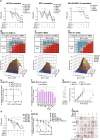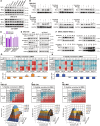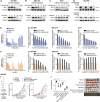Both direct and indirect suppression of MCL1 synergizes with BCLXL inhibition in preclinical models of gastric cancer
- PMID: 40075071
- PMCID: PMC11904182
- DOI: 10.1038/s41419-025-07481-8
Both direct and indirect suppression of MCL1 synergizes with BCLXL inhibition in preclinical models of gastric cancer
Abstract
Despite the progress of treatment in gastric cancer (GC), the overall outcomes remain poor in patients with advanced diseases, underscoring the urgency to develop more effective treatment strategies. BH3-mimetic drugs, which inhibit the pro-survival BCL2 family proteins, have demonstrated great therapeutic potential in cancer therapy. Although previous studies have implicated a role of targeting the cell survival pathway in GC, the contribution of different pro-survival BCL2 family proteins in promoting survival and mediating resistance to current standard therapies in GC remains unclear. A systematic study to elucidate the hierarchy of these proteins using clinically more relevant GC models is essential to identify the most effective therapeutic target(s) and rational combination strategies for improving GC therapy. Here, we provide evidence from both in vitro and in vivo studies using a broad panel of GC cell lines, tumoroids, and xenograft models to demonstrate that BCLXL and MCL1, but not other pro-survival BCL2 family proteins, are crucial for GC cells survival. While small molecular inhibitors of BCLXL or MCL1 exhibited some single-agent activity, their combination sufficed to cause maximum killing. However, due to the unsolved cardiotoxicity associated with direct MCL1 inhibitors, finding combinations of agents that indirectly target MCL1 and enable the reduction of doses of BCLXL inhibitors while maintaining their anti-neoplastic effects is potentially a feasible approach for the further development of these compounds. Importantly, inhibiting BCLXL synergized significantly with anti-mitotic and HER2-targeting drugs, leading to enhanced anti-tumour activity with tolerable toxicity in preclinical GC models. Mechanistically, anti-mitotic chemotherapies induced MCL1 degradation via the ubiquitin-proteasome pathway mainly through FBXW7, whereas HER2-targeting drugs suppressed MCL1 transcription via the STAT3/SRF axis. Moreover, co-targeting STAT3 and BCLXL also exhibited synergistic killing, extending beyond HER2-amplified GC. Collectively, our results provide mechanistic rationale and pre-clinical evidence for co-targeting BCLXL and MCL1 (both directly and indirectly) in GC. (i) Gastric cancer cells rely on BCLXL and, to a lesser degree, on MCL1 for survival. The dual inhibition of BCLXL and MCL1 with small molecular inhibitors acts synergistically to kill GC cells, regardless of their TCGA molecular subtypes or the presence of poor prognostic markers. While the effect of S63845 is mediated by both BAX and BAK in most cases, BAX, rather than BAK, acts as the primary mediator of BCLXLi in GC cells. (ii) Inhibiting BCLXL significantly synergizes with anti-mitotic and HER2-targeting drugs, leading to enhanced anti-tumour activity with tolerable toxicity in preclinical GC models. Mechanistically, anti-mitotic chemotherapies induce MCL1 degradation via the ubiquitin-proteasome pathway mainly through FBXW7, whereas HER2-targeting drugs suppress MCL1 transcription via the STAT3/SRF axis. The combination of the STAT3 inhibitor and BCLXL inhibitor also exhibits synergistic killing, extending beyond HER2-amplified GC.
© 2025. The Author(s).
Conflict of interest statement
Competing interests: J.N.G. is a former employee of the Walter and Eliza Hall Institute of Medical Research, who receives milestones and royalty payments related to venetoclax. All the other authors declare no conflicts of interest. Ethics approval and consent to participate: All methods were performed in accordance with the relevant guidelines and regulations. Fresh tumor tissues were collected from GC patients during surgery after written informed consent was obtained. The study was performed with the approval of the National Cancer Center/National Clinical Research Center for Cancer/Cancer Hospital (17-156/1412) and the Institute of Laboratory Animal Sciences (GJN22002), Chinese Academy of Medical Sciences and Peking Union Medical College. Animal study was approved by the Institutional Animal Care and Use Committee of the Institute of Laboratory Animal Sciences, Chinese Academy of Medical Sciences, and Peking Union Medical College (IACUC 21001).
Figures







References
-
- Bray F, Laversanne M, Sung H, Ferlay J, Siegel RL, Soerjomataram I, et al. Global cancer statistics 2022: GLOBOCAN estimates of incidence and mortality worldwide for 36 cancers in 185 countries. CA Cancer J Clin. 2024;74:229–63. - PubMed
-
- Taieb J, Bennouna J, Penault-Llorca F, Basile D, Samalin E, Zaanan A. Treatment of gastric adenocarcinoma: a rapidly evolving landscape. Eur J Cancer. 2023;195:113370. - PubMed
-
- Lu J, Zheng ZF, Wang W, Xie JW, Wang JB, Lin JX, et al. A novel TNM staging system for gastric cancer based on the metro-ticket paradigm: a comparative study with the AJCC-TNM staging system. Gastric Cancer. 2019;22:759–68. - PubMed
-
- Souers AJ, Leverson JD, Boghaert ER, Ackler SL, Catron ND, Chen J, et al. ABT-199, a potent and selective BCL-2 inhibitor, achieves antitumor activity while sparing platelets. Nat Med. 2013;19:202–8. - PubMed
MeSH terms
Substances
LinkOut - more resources
Full Text Sources
Medical
Research Materials
Miscellaneous

